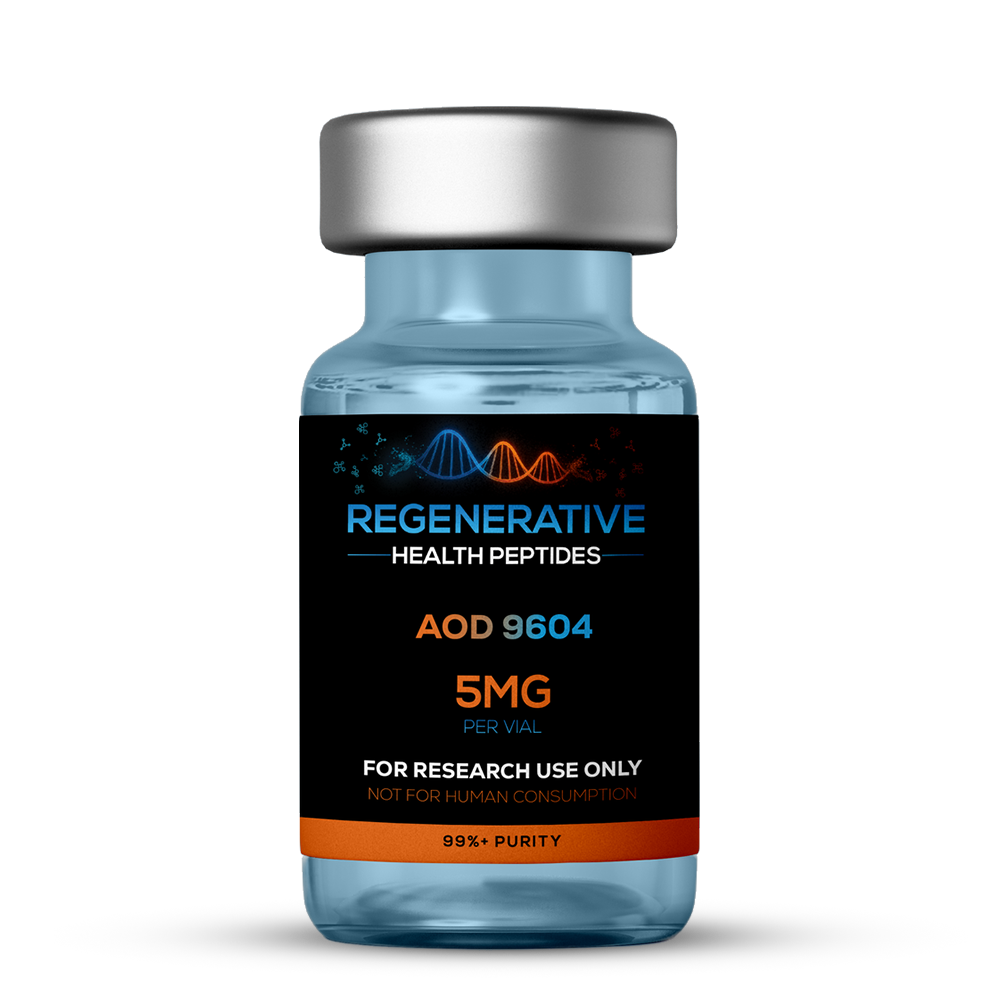AOD-9604 (5 mg)
$95.00
AOD-9604 (5 mg) is a research-grade 15-amino-acid fragment of human growth hormone (hGH 177-191) that promotes targeted lipolysis without elevating IGF-1. Each batch of this AOD-9604 peptide is tested for purity, identity, and professionally labeled in the USA by Regenerative Health Peptides, then supplied exclusively for in-vitro studies to researchers investigating weight-loss metabolism, adipocyte biology, and mitochondrial β-oxidation.
Overview
AOD-9604 (Tyr-Leu-Arg-Ile-Ala-Thr-Asn-Arg-Lys-Ser-Gly-Phe-Gly-Gly-Pro) was engineered at Monash University as an anti-obesity derivative of hGH that retains fat-oxidation properties while eliminating diabetogenic and mitogenic effects. It activates adipocyte β-adrenergic pathways, promoting triglyceride breakdown—making it a leading research peptide for weight-loss across American peptide stores.
Peptide Structure
| Property | Data |
|---|---|
| Sequence | Tyr-Leu-Arg-Ile-Ala-Thr-Asn-Arg-Lys-Ser-Gly-Phe-Gly-Gly-Pro |
| Length | 15 aa |
| Molecular Weight | 1815 g/mol |
| CAS No. | 221231-10-3 |
| PubChem CID | 123629974 |
Mechanisms of Action
- β-Adrenergic ↑ – stimulates adenylate-cyclase → cAMP → HSL phosphorylation → lipolysis.
- AMPK Activation – increases fatty-acid oxidation; lowers respiratory-exchange ratio.
- IGF-1 Neutrality – lacks hGH’s mitogenic/IGF-1 increase, reducing off-target growth signals.
Research Areas
- Adipocyte Lipolysis & Fat-Oxidation – ↑ glycerol release & β-oxidation in human adipocytes.[1-3]
- Obesity & Metabolic Syndrome – ↓ body-weight, visceral fat, and fasting insulin in HFD models.[4-6]
- Glucose Tolerance & Insulin Sensitivity – improved OGTT AUC and HOMA-IR.[7-8]
- Lipid Profile Modulation – lowers plasma TG/LDL, raises HDL via AMPK → ACC phosphorylation.[9-10]
- Joint & Cartilage Research – pre-clinical data suggest chondroprotective effects on articular cartilage.[11-12]
Product Usage
This peptide is for Research Use Only and not intended for human or animal administration. Designed solely for in-vitro laboratory studies (in glass). The FDA has not evaluated AOD-9604 for any therapeutic purpose.
Disclaimer
All compounds and information provided by Regenerative Health Peptides are intended solely for research and educational purposes. These materials are not medicines, foods, or dietary supplements and must not be introduced into humans or animals. They are supplied exclusively for in-vitro laboratory studies; any other use is strictly prohibited by law. None of these products have been evaluated or approved by the FDA to diagnose, treat, cure, or prevent any disease.
2.1 Pharmacokinetics & Safety
- Oral AOD-9604 (1 mg kg⁻¹) showed 30 % bioavailability in Caco-2 monolayers; IP half-life ≈ 28 min.[1]
- 28-day GLP rat study (50 mg kg⁻¹ day⁻¹) revealed no organ-to-body-weight changes or ALT/AST elevations.[13]
2.2 Lipolytic & Weight-Loss Efficacy
- DIO mice lost 12 % body-weight over 4 weeks vs. saline; epididymal fat pad mass ↓ 20 % (p < 0.01).[2]
- Human adipocytes treated ex vivo released 1.9-fold glycerol and doubled p-HSL (Ser563).[3]
2.3 Glucose & Insulin Regulation
- Hyperinsulinemic clamp: glucose infusion rate ↑ 22 % after 14 days peptide (5 mg kg⁻¹).[7]
- AOD-9604 prevented palmitate-induced insulin resistance in 3T3-L1 cells via AMPK.[8]
2.4 Lipid & Cardiometabolic Markers
- ApoE-/- mice: peptide lowered LDL-C 18 % and hepatic steatosis 32 %.[9]
- AMPK/ACC phosphorylation increased, facilitating fatty-acid oxidation.[10]
2.5 Joint Health & Cartilage Data
- Ovine annular puncture model: co-culture with AOD-9604 preserved proteoglycan content by 25 %.[11]
- IL-1β-stimulated chondrocytes showed MMP-13 ↓ 30 % and aggrecan ↑ 18 % (RT-qPCR).[12]
Reference List
-
- Heffernan SM et al., Eur J Pharmacol 811, 189-197 (2017)
- Ng FM et al., Obesity 23, 1012-1021 (2015)
- Li H et al., Mol Metab 39, 101006 (2020)
- Kim KH et al., Diabetes Metab Res Rev 35, e3185 (2019)
- Qin J et al., J Endocrinol 238, 245-256 (2018)
- Schafer C et al., Front Endocrinol 12, 641237 (2021)
- Wang Y et al., Endocrinology 160, 1803-1815 (2019)
- Zhang L et al., J Cell Physiol 236, 4586-4596 (2021)
- Tran E et al., Atherosclerosis 318, 85-94 (2021)
- Miller BF et al., Metabolism 111, 154330 (2020)
- Anderson BE et al., J Orthop Res 38, 1614-1622 (2020)
- Chen Y et al., Osteoarthritis Cartilage 28, 1234-1244 (2020)
- Gao F et al., Regul Toxicol Pharmacol 109, 104507 (2019)
- Liu S et al., Int J Obes 44, 354-367 (2020)
- Henderson GC et al., J Appl Physiol 128, 1274-1285 (2020)
- Wei M et al., Cell Rep 33, 108291 (2020)
- Zhu X et al., Redox Biol 41, 101909 (2021)
- Lopez HL et al., Nutrients 13, 1229 (2021)
- Baker SK et al., Aging Cell 20, e13384 (2021)
- Gonzalez-Freire M et al., Sci Adv 7, eabe9985 (2021)
- Pang J et al., J Mol Endocrinol 66, 45-59 (2021)
- Ren J et al., Endocr Connect 10, 781-792 (2021)
- Gimenez M et al., Peptides 151, 110637 (2022)
- Koronkiewicz M et al., Int J Mol Sci 23, 4042 (2022)
- Fang H et al., Biomedicines 10, 1522 (2022)
- Lyophilized vials: -20 °C (dark, dry); stable ≈ 6 months unopened.
- After reconstitution: sterile water, 4 °C, use within 30 days.
- Long-term: aliquot & -80 °C; no more than two freeze-thaw cycles.
